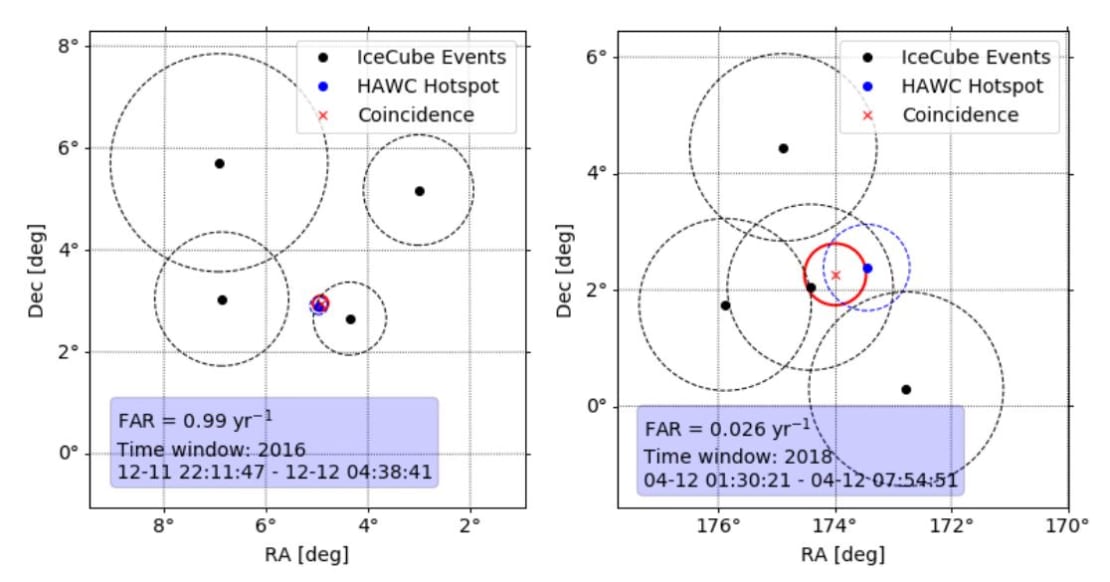2017 was a momentous year for the field of multimessenger astronomy. In August, a neutron star collision produced a gravitational wave that was observed by the LIGO and Virgo collaborations at nearly the exact same time a gamma-ray burst was detected by the Fermi space telescope. A month later, the IceCube Neutrino Observatory recorded an astrophysical neutrino event that was followed by a weeklong gamma-ray flare detected by the Fermi and MAGIC telescopes. These landmark detections proved that astronomers could gain a more complete understanding of the universe by combining observations of different wavelengths and, for the first time since 1987 when a supernova was last observed, different messenger particles from a variety of detectors across the globe.
Understanding how and where these messenger particles are produced, and using these observations to explore the physics of the universe, requires an ongoing stream of multimessenger detections. The Astrophysical Multimessenger Observatory Network (AMON) can help with that. Created in 2013 to facilitate the interaction of different observatories, AMON recently commissioned real-time multimessenger alerts that notify the astrophysical community when two or more observatories detect an interesting “coincidence” of events that may be worthy of follow-up observations. Their analysis takes advantage of abundant subthreshold data from the IceCube Neutrino Observatory and the High-Altitude Water Cherenkov (HAWC) gamma-ray observatory.
In a paper submitted today to The Astrophysical Journal, the AMON team, together with the IceCube and HAWC collaborations, presents the analysis approach that they developed and reveal the first results from their analysis, as applied to three years of archival data from 2015 to 2018. Among those three years, they identified two coincident events that met their criteria for distribution as a public alert, but there were no particularly important astronomical sources seen near either position. Going forward, real-time analyses of data from the IceCube and HAWC observatories will allow interesting coincidences to be identified and reported as they happen, enabling quick follow-up observations from astronomers around the world.

The IceCube Neutrino Observatory is an array of over 5,000 light sensors frozen into a cubic kilometer of ice below the surface at the South Pole. HAWC, located in a very different, mountainside environment in Puebla, Mexico, is an array of 300 aboveground water tanks that hold four light sensors each. Both are designed to observe Cherenkov radiation—light emitted when charged particles travel at close to the speed of light in ice or water—that is produced by high-energy particles sent to Earth by the most cataclysmic events in the universe.
The bulk of the data collected by IceCube and HAWC are dominated by background particles produced in Earth’s atmosphere, rather than in cosmic sources, making it difficult to determine whether any individual event is of interest for astrophysical studies. But there could still be signal events hidden among those subthreshold data. And that’s where AMON comes in.
The AMON algorithm is designed to analyze subthreshold data from IceCube and HAWC in real time. It looks for coincidences between IceCube neutrino events and HAWC “hotspots”—locations on the sky where a higher-than-expected number of gamma-ray events were observed over the course of a day. To be considered a coincident event, the neutrino event must have arrived within a window of time that matches the HAWC hotspot and must be close to the HAWC hotspot localization on the sky. Once a coincidence is found and reported, researchers can carry out follow-up observations to identify any new or unusual sources near that position.
In their paper, the researchers report a systematic analysis of archival IceCube and HAWC data, from June 2015 to August 2018, with the AMON algorithm. Within the three years of nearly continuous data collection by both observatories, two coincident neutrino–gamma-ray clusters were judged sufficiently interesting that they would have been distributed as public alerts if the analysis had been running in real time. The analysis shows that both coincidences are very rare—with one occurring once per year and the second every 30 years—but still not rare enough to support a claim that they must be from cosmic sources.
Next, the researchers referred to astronomical catalogs in search of interesting or unusual objects that might have emitted neutrinos and gamma rays near the two coincident clusters. They found some known galaxies and quasars but no sources so unusual that they stood out on their own. Still, the story isn’t over; follow-up optical or X-ray observations of select nearby sources might provide further clues as to whether they are related to the reported neutrino–gamma-ray clusters.
“These events illustrate the power of this approach to be able to identify statistically rare clusters of neutrinos and gamma rays—cosmic ‘needles in a haystack,’ as it were—as intended,” says Hugo Alberto Ayala Solares, a postdoctoral researcher at Pennsylvania State University and the lead on this analysis.
In November 2019, AMON, IceCube, and HAWC initiated the real-time version of this analysis. A couple of months later, on February 2, the first real-time alert from this system went out, but this cluster also did not lead to any high-confidence association with a source.
Next time a statistically rare coincidence of neutrinos and gamma rays is observed, AMON systems will once again send out an alert to AMON follow-up partners as well as the astrophysical community through the Gamma-Ray Coordinates Network (GCN). “If the universe is in a generous mood, these observations may lead to discovery of the next multimessenger source,” says Derek Fox, a co-principal investigator of AMON and associate professor of astronomy and astrophysics at Pennsylvania State University.
As shown by the events in 2017, having information from all possible messengers helps researchers obtain a better picture of a variety of astrophysical phenomena. Implementing searches in real time, as with AMON, will advance the field of multimessenger astronomy further and bring us closer to a deeper understanding of the universe.
info “Multimessenger gamma-ray and neutrino coincidence alerts using HAWC and IceCube sub-threshold data,” the AMON Team, HAWC Collaboration, and IceCube Collaboration: Ayala Solares et al., The Astrophysical Journal 906 (2021) 63, iopscience.iop.org, arxiv.org/abs/2008.10616